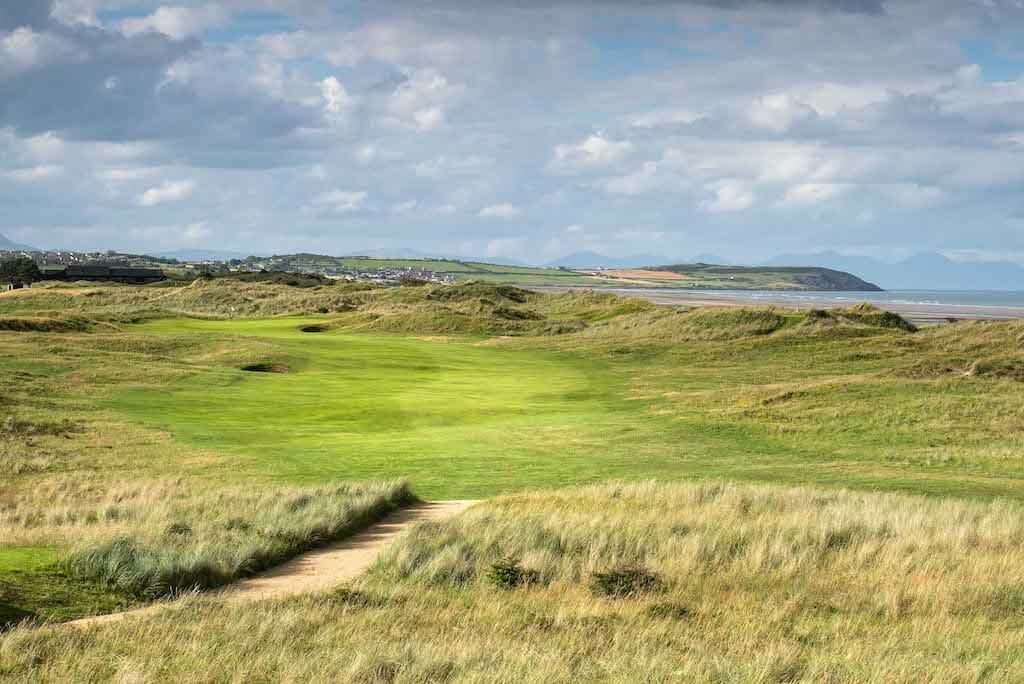It was early July and Leona Maguire had just won the Flogas Irish Scratch Series earlier in the day when I arrived to play Seapoint. It had been four years since my last visit and I knew much had changed. Not in terms of layout but the conditioning, shaping and the ‘links’ experience have taken Seapoint to a new level.
Just look at the greens. Just look at the bunkers. Just look at the rough. And when you get to 16, 17 and 18, you’ll get the whole wild links and sea vibe. There is an imbalance in the holes here – no one would deny that – but what a climax to the round as these final three holes all head straight back to the clubhouse using the most muscular dunes above the beach.
I like the story behind Seapoint – I like anything Des Smyth related – and I particularly like the ongoing efforts to push Seapoint forwards. The course condition is excellent, the ‘peripherals’ add considerably to the experience, and greens trick you constantly and bring out your best. Peripherals, by the way, mean things you barely notice: e.g. golden grasses around tee boxes, hand cut edges, the quality of paths, and extended aprons around greens providing more traditional roll-off areas. They all enhance your round and prove that the little things add up to make a big impact. And then there’s the new branding which is still being rolled out across the club.
So, in my world, as someone who writes about golf courses, the big question is how do you discuss your round at Seapoint?
I doubt many golfers prefer the front nine over the back nine, despite the 5th being Des’s favourite hole. It’s tough on those opening holes because everyone knows that the best streak comes at the end, teeing off at the 14th (although the 11th is one of my favourites). There are good holes on the front (5, 6, 7 and 9 stand out) but – and this is a personal thing – I find that the houses built on the property just interrupt the rhythm and get in my eyeline. Most golfers probably don’t even notice but it interferes with my view of the hole. The 1st is a perfect example.
What’s more, I actually think the 1st is a great hole. The opening drive immediately asks the golfer to make a choice: go big, split the bunkers and reach the crest, thereby revealing the green and its hazards; or lay up and play a blind or semi-blind approach to the green below, fronted by a dyke. If you go for the long option and miss the fairway you’ll discover golden, wispy rough or, worse, the bunker buried in the left hand hump. It’s a tough hole, as the Index 7 makes clear.
Des’s favourite, the 5th, is also Index 1. You drive over a pond into a left–to–right dogleg with a landing area bigger than first appears. More often than not those landing areas are generous at Seapoint, and they need to be because greens are small, bunkers are deep and attentive, and run-offs are slippery. On the 5th, the risk is all water with a large pond hugging a small green. It makes for a daunting approach. It also shows off one of the key (and recent) attributes of Seapoint: not only does bump-and-run work a charm, but the greens and fairways blend almost seamlessly. It can be difficult to tell where fairways end and greens begins. That’s perfect conditioning for you.
That left-to-right dogleg is repeated on 6 and 7. The first is a smart par five around or over a line of low dunes with a devious green complex of humps and swales. A long par four follows and then the par three 9th takes you back to the clubhouse where the green sits in a low nest of tricky dunes. The openness of this front nine may not quite grab you but the greens most definitely shine. Miss a few of them and you’ll see what I mean.
The back nine introduces more shape to the terrain and more links’ subtleties as you get closer to the sea and the wide expanses of Termonfeckin Beach.
By now you’ll have realised that you are using a lot of clubs in your bag. I had a good day with the driver and found most of the wide fairways but still used the three iron twice on par fours (holes 7 and 12) and my five iron once (hole 3)… and not just because of the wind. That makes for good variety and while most drives allow you to open the shoulders, there are some (holes 1, 5, 11) where a more strategic approach could be the wiser option. That 11th, for example, is a cracking hole and all on show from the tee. A swamp of bunkers fills the dogleg elbow, between tee and green, and it invites you to blast a drive over the sand. Rookie mistake. You’re not DeChambeau so play the percentages and veer left.
For many, Seapoint builds to a crescendo from the 14th on. Ironically, after what people say about the ‘parkland’ traits of holes 3 to 5, the enigmatic 14th has the most trees. They don’t interfere with your drive but they can certainly influence your approach shot as well as providing a brooding backdrop. Much of the putting surface is hidden by a bunker-stuffed shoulder and that makes it the trickiest approach shot of the day. The two par threes (15 and 17) are excellent, with the long, thin green on 17 particularly difficult to hit. You’ll have been distracted, too, as the high tee box displays the full splendour of the views and the beach and sea beside you. New tee boxes were built on 17 and 18, in 2016, and they show off the holes and views in spectacular fashion. Combine those with the 16th and you have the straightest final three-hole stretches in Ireland. The par four 16th is a wonderful links hole with the most rippling of fairways… but it is also known as the hole that butts up to Co. Louth Golf Club, and where a few steps will take you onto that course’s 14th tee. It is a glorious place to stand and look over these two stretches of links holes. I suspect that 80 percent of visitors will wander up to the divide for a better look. And why not. Compare away.
With all the added flourishes of late and the hard work ongoing at Seapoint, you can be sure of a strong challenge from a course that sees the point of progress and strong conditioning.
At The Club
To find out a bit more of what’s been going on at the club, I spoke to Jim McMorrow, the club’s Chairman.
How are you focusing on continued, long-term sustainable growth?
“It became evident through 2018 and 2019 that fewer members were actively playing, our restaurant and bar model wasn’t sustainable, the member and visitor experience needed improvement and surrounding golf clubs were being more aggressive in targeting new members.
“The starting point was to identify who we were and what type of club we wanted to be. We engaged members with a new vision for Seapoint Golf Links: ‘To respect the past, live in the present and plan for the future.’ Our goal is to be recognised as the best provincial Golf Club in the area, with an engaged membership enjoying a strong social and golf programme.”
“The first step was to outsource catering services to a third party provider, and then to inject more professionalism into the club’s day-to-day golf and commercial operations. After a procurement process, in Autumn 2019, we awarded a long-term management contract to Carr Golf.”
Head Greenkeeper, Noel Mooney’s team has been working under the guidance of Carr Golf and their Regional Superintendent since earlier this year.
What has been done to achieve the current level of conditioning?
“We’re delighted with the improvements. The team’s worked hard and long-standing members tell me the course is in the best shape it’s been in since the early years, when Seapoint first opened in 1993. Our focus is to elevate Seapoint’s conditioning back to the levels experienced when we hosted the Irish PGA and Irish Close in 2014. We’re improving the views from the tee boxes and carries over rough to give the course a more traditional links feel.”
The club has, like many others during the Covid-19 months, attracted new members but Seapoint has grown by over 140 which is impressive by any standard.
How did you attract these members… and what categories do they fall into?
“There’s no secret formula to growing a membership: it’s promotion and old-fashioned selling to those you suspect have an interest in joining. We’ve focused on targeting 25-40-year olds, having recently reviewed our Intermediate categories to make them more appealing to golfers who are in a phase of life that often involves competing financial pressures.
“Increasing our online presence through social media content and paid advertising has certainly been a factor in driving enquiries while retaining our members, old and new, is a key pillar in our long-term strategic growth plan.”























Leave a comment